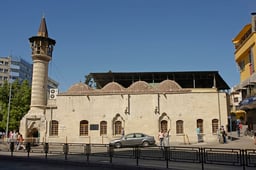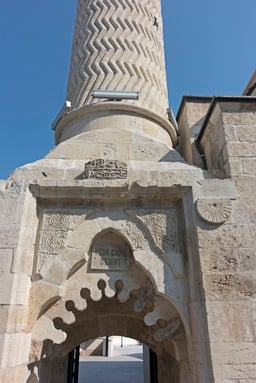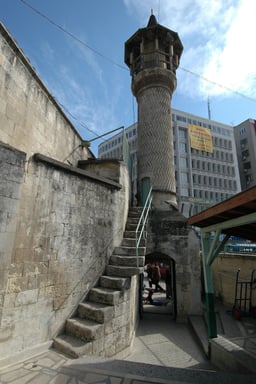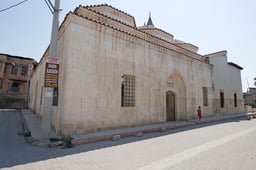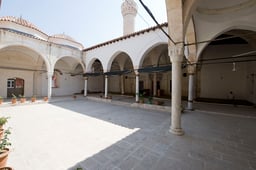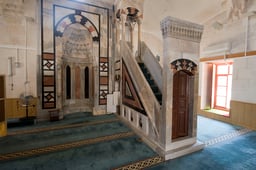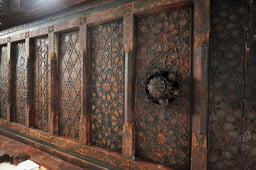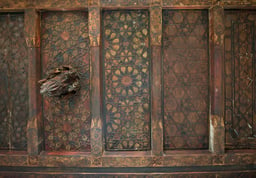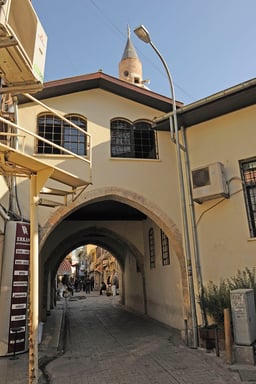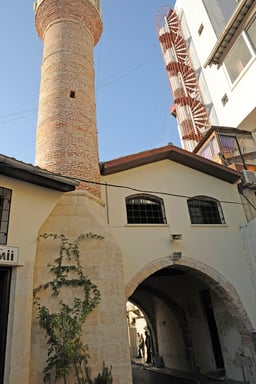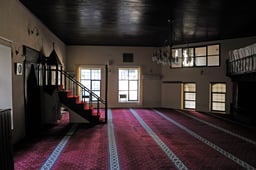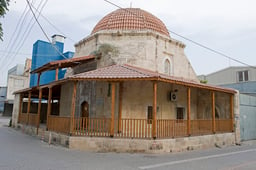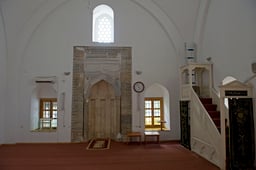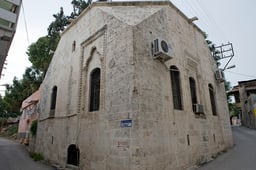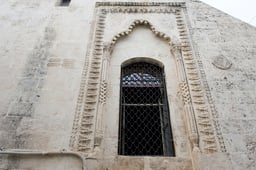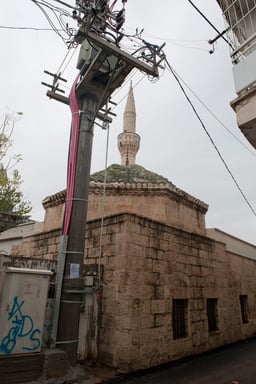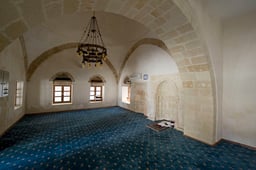Adana
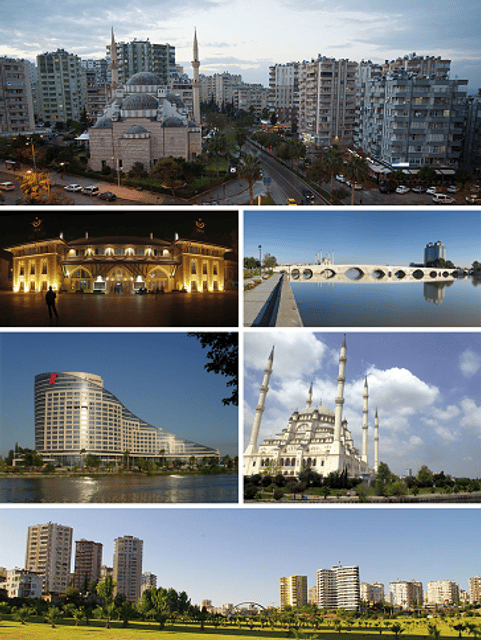
Adana

| Coordinates: | |
| Country | Turkey |
|---|---|
| Region | Mediterranean |
| Province | Adana |
| Founded | 6000BC (8019 years ago) |
| Incorporated | 1871 (148 years ago) |
| Districts | ,Yüreğir,Çukurova,Sarıçam |
| Government | |
| • Type | Mayor-council government |
| • Body | Adana Metropolitan Municipality |
| • Mayor | Zeydan Karalar (CHP) |
| Area | |
| • Total | 1,945 km(751 sq mi) |
| Elevation | 23 m (75 ft) |
| Population | 1,747,567 |
| • Density | 892.83/km(2,312.4/sq mi) |
| Time zone | UTC+3(FET) |
| Postal code | |
| Area code(s) | 0322 |
| Licence plate | 01 |
| Website | |
Adana (pronounced [aˈda.na]; Armenian: Ադանա; Ancient Greek: Άδανα, Arabic: أضنة) is a major city in southern Turkey. The city is situated on the Seyhan river, 35 km (22 mi) inland from the Mediterranean, in south-central Anatolia. It is the administrative seat of the Adana Province and has a population of 1.75 million,[1] making it the 5th most populated city in Turkey. The Adana-Mersin polycentric metropolitan area, with a population of 3 million, stretches over 70 km (43 mi) east-west and 25 km (16 mi) north-south; encompassing the cities of Mersin, Tarsus and Adana.
Adana lies in the heart of Cilicia, a geo-cultural region locally known as Çukurova. Home to six million people,[2] Cilicia is one of the largest population concentrations in Turkey, as well as the most agriculturally productive area, owing to its large stretch of flat, fertile land. The region includes the provinces of Mersin, Adana, Osmaniye and Hatay.
| Coordinates: | |
| Country | Turkey |
|---|---|
| Region | Mediterranean |
| Province | Adana |
| Founded | 6000BC (8019 years ago) |
| Incorporated | 1871 (148 years ago) |
| Districts | ,Yüreğir,Çukurova,Sarıçam |
| Government | |
| • Type | Mayor-council government |
| • Body | Adana Metropolitan Municipality |
| • Mayor | Zeydan Karalar (CHP) |
| Area | |
| • Total | 1,945 km(751 sq mi) |
| Elevation | 23 m (75 ft) |
| Population | 1,747,567 |
| • Density | 892.83/km(2,312.4/sq mi) |
| Time zone | UTC+3(FET) |
| Postal code | |
| Area code(s) | 0322 |
| Licence plate | 01 |
| Website | |
Etymology
According to numerous sources, the name Adana is derived from the Hittite URUAdaniya of Kizzuwatna,[3] while others assert that it is related to the legendary character Danaus, or to the Danaoi, a mythological Greek tribe from the Greek city Argos. Maybe they are both related. The earlier Egyptian texts for a country Danaja are inscriptions from Thutmosis II (1437 BC) and Amenophis III (1390–1352 BC).[4]or [5] is connected with the PIE da-nu (river) (as in river Danu-be) Da-na-vo (people living by the river), Scythian nomad people, water demons in Rigveda (Danavas).[6]
The Denyen are also believed to have settled in Cyprus. Furthermore, a Hittite report[7] speaks of a Muksus, who also appears in an eighth-century bilingual inscription from Karatepe stele in Cilicia. The kings of Adana are traced from the Greek "house of Mopsos," given in hieroglyphic Luwian as Moxos and in Phoenician as Mopsos, in the form mps. They were called the Dananiyim.[8] The area also reports a Mopsukrene ("Mopsus' fountain" in Greek) and a Mopsuestia ("Mopsus' hearth" in Greek), also in Cilicia. In addition to all that, a lot of Mycenaean bronzes and pottery have been found in the area.[9][10]
In Hellenistic times, it was known as Antiochia in Cilicia (Ἀντιόχεια τῆς Κιλικίας) or Antiochia ad Sarum (Ἀντιόχεια ἡ πρὸς Σάρον; "Antiochia on the Sarus"). The editors of The Helsinki Atlas tentatively identify Adana as Quwê (as contained in cuneiform tablets), the Neo-Assyrian capital of Quwê province. The name also appears as Coa and may be the place referred to in the Bible, where King Solomon obtained horses. (I Kings 10:28; II Chron. 1:16).[11] The Armenian name of the city is Ատանա Atana or Ադանա Adana.
According to an ancient Greco-Roman legend, the name has its origins in Adanus and Sarus, the two sons of Uranus, who came to a place near the Seyhan (Sarus) River, where they built Adana.[12] An older legend relates the city's name to Adad (also known as Tesup or Ishkur), the Thunder God in the Akkadian, Sumerian, Babylonian, Assyrian and Hittite mythologies, who was believed to live in the nearby forest, and whose name was given to the region. The Hittites' names and writings have been found in the area, evidencing this possibility. The theory goes that since the Thunder God brought so much rain and this rain in turn brought such great abundance in this particular region, this god was loved and respected by its inhabitants and, in his honor, the region was called the "Uru Adaniyya"; in other words "the Region of Ada".
Adana's name has had many different versions over the centuries: Adanos, Ta Adana, Uru Adaniya, Erdene, Edene, Ezene, Batana, Atana, Azana, Addane.
Geography
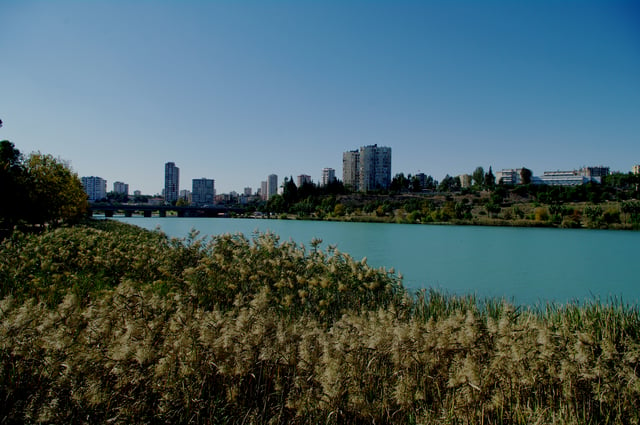
Eskibaraj Dam Lake on Seyhan River.
Adana is located at the northeastern edge of the Mediterranean, where it serves as the gateway to the Çukurova plain, which has historically been known in the West as the Cilicia plain. This large stretch of flat, fertile land lies southeast of the Taurus Mountains.
From Adana, crossing the Çukurova westwards, the road from Tarsus enters the foothills of the Taurus Mountains, eventually reaching an altitude of nearly 4,000 feet (1,200 m).
It goes through the famous Cilician Gates, the rocky pass through which armies have coursed since the dawn of history, and continues to the Anatolian plain.
The north of the city is surrounded by the Seyhan reservoir.
The Seyhan Dam, completed in 1956, was constructed for hydroelectric power and to irrigate the lower Çukurova plain.
Two irrigation channels in the city flow to the plain, passing through the city center from east to west.
There is another canal for irrigating the Yüreğir plain to the southeast of the city.
The 37th parallel north passes through the city.
Climate
Adana has a hot-summer Mediterranean climate (Csa) under both the Köppen classification, and a dry-hot summer subtropical climate (Csa) under the Trewartha classification. Winters are mild and wet. Summers are long, hot, humid and dry. The highest recorded temperature was on 8 July 1978 at 45.6 °C (114.1 °F). The lowest recorded temperature was −8.1 °C (17.4 °F).
| Climate data for Adana (1927–2017) | |||||||||||||
|---|---|---|---|---|---|---|---|---|---|---|---|---|---|
| Month | Jan | Feb | Mar | Apr | May | Jun | Jul | Aug | Sep | Oct | Nov | Dec | Year |
| Record high °C (°F) | 26.5(79.7) | 28.5(83.3) | 32.0(89.6) | 37.5(99.5) | 41.3(106.3) | 42.8(109.0) | 44.0(111.2) | 45.6(114.1) | 43.2(109.8) | 41.5(106.7) | 34.3(93.7) | 30.8(87.4) | 45.6(114.1) |
| Average high °C (°F) | 14.7(58.5) | 16.1(61.0) | 19.3(66.7) | 23.6(74.5) | 28.2(82.8) | 31.7(89.1) | 33.8(92.8) | 34.6(94.3) | 33.1(91.6) | 28.9(84.0) | 22.5(72.5) | 16.7(62.1) | 25.3(77.5) |
| Daily mean °C (°F) | 9.5(49.1) | 10.5(50.9) | 13.4(56.1) | 17.5(63.5) | 21.7(71.1) | 25.6(78.1) | 28.2(82.8) | 28.7(83.7) | 26.1(79.0) | 21.6(70.9) | 15.8(60.4) | 11.2(52.2) | 19.1(66.4) |
| Average low °C (°F) | 5.1(41.2) | 5.9(42.6) | 8.1(46.6) | 11.8(53.2) | 15.6(60.1) | 19.6(67.3) | 22.8(73.0) | 23.2(73.8) | 20.0(68.0) | 15.5(59.9) | 10.6(51.1) | 6.8(44.2) | 13.8(56.8) |
| Record low °C (°F) | −8.1(17.4) | −6.6(20.1) | −4.9(23.2) | −1.3(29.7) | 5.6(42.1) | 9.2(48.6) | 11.5(52.7) | 14.8(58.6) | 9.3(48.7) | 3.5(38.3) | −4.3(24.3) | −4.4(24.1) | −8.1(17.4) |
| Averageprecipitationmm (inches) | 107.6(4.24) | 90.0(3.54) | 65.4(2.57) | 51.3(2.02) | 47.3(1.86) | 20.4(0.80) | 6.3(0.25) | 5.6(0.22) | 17.8(0.70) | 42.1(1.66) | 71.7(2.82) | 119.1(4.69) | 644.6(25.38) |
| Average precipitation days | 12.1 | 10.9 | 10.7 | 10.0 | 7.5 | 3.7 | 1.2 | 1.1 | 3.4 | 6.8 | 8.0 | 11.4 | 86.8 |
| Mean monthlysunshine hours | 139.5 | 149.7 | 186.0 | 213.0 | 282.1 | 318.0 | 334.8 | 322.4 | 270.0 | 229.4 | 177.0 | 136.4 | 2,758.3 |
| Mean dailysunshine hours | 4.5 | 5.3 | 6.0 | 7.1 | 9.1 | 10.6 | 10.8 | 10.4 | 9.0 | 7.4 | 5.9 | 4.4 | 7.5 |
| Source:Turkish State Meteorological Service[13] | |||||||||||||
History
The history of the Tepebağ tumulus in the middle of Adana dates to the Neolithic Period, 6000 B.C., and the time of the first human settlements. It is considered to be the oldest city of the Çukurova region. A place called Adana is mentioned by name in a Sumerian epic, the Epic of Gilgamesh, but the geography of this work is too imprecise to identify its location.
Classical era
According to the Hittite inscription of Kava, found in Hattusa (Boğazkale), Kizzuwatna was the first kingdom that ruled Adana, under the protection of the Hittites by 1335 BC. At that time, the name of the city was Uru Adaniyya, and the inhabitants were called Danuna. Beginning with the collapse of the Hittite Empire, c. 1191–1189 BC, invasions from the west caused a number of small kingdoms to take control of the plain, as follows: Quwê Assyrians, 9th century BC; Persians, 6th century BC; Alexander the Great in 333 BC; Seleucids; the pirates of Cilicia; Roman statesman Pompey the Great; and the Armenian Kingdom of Cilicia (Cilician Kingdom).
The history of Adana is intrinsically linked to the history of Tarsus; they often seem to be the same city, moving as the neighboring Seyhan River changed its position.
Their respective names also changed over the course of the centuries.
Adana was of relatively minor importance during the Roman's influential period, while nearby Tarsus was the metropolis of the area. During the era of Pompey, the city was used as a prison for the pirates of Cilicia. For several centuries thereafter, it was a waystation on a Roman military road leading to the East. After the permanent split of the Roman Empire in 395 AD, the area became a part of the Byzantine Empire, and was probably developed during the time of Julian the Apostate. With the construction of large bridges, roads, government buildings, irrigation and plantation, Adana and Cilicia became the most developed and important trade centers of the region. Ayas (today Yumurtalık), and Kozan (formerly Sis) were the other major urban and administrative centers in the area, especially during the period of the Cilicians.
Byzantine era
Adana was included in the Roman province of Cilicia Prima, whose capital was Tarsus. It became a Christian bishopric, a suffragan of the metropolitan see of Tarsus, but was raised to the rank of autocephalous archdiocese after 680, the year in which its bishop appeared as a simple bishop at the Third Council of Constantinople, but before its listing in a 10th-century Notitiae Episcopatuum
Its bishop Paulinus participated in the First Council of Nicaea in 325. Piso was among the Arianism-inclined bishops at the Council of Sardica (344) who withdrew and set up their own council at Philippopolis; he later returned to orthodoxy and signed the profession of Nicene faith at a synod in Antioch in 363. Cyriacus was at the First Council of Constantinople in 381. Anatolius is mentioned in a letter of Saint John Chrysostom. Cyrillus was at the Council of Ephesus in 431 and at a synod in Tarsus in 434. Philippus took part in the Council of Chalcedon in 451[14] and was a signatory of the joint letter of the bishops of Cilicia Prima to Byzantine Emperor Leo I the Thracian in 458 protesting at the murder of Proterius of Alexandria. Ioannes participated in the Third Council of Constantinople in 680.[15][16] No longer a residential bishopric, Adana is today listed by the Catholic Church as a titular see.[17]
Middle Ages
In the mid-7th century, the city was captured by the Arabs. According to an Arab historian of that era,[18] the name of the city was derived from Ezene, the prophet Yazene's grandson.
The Byzantines recaptured Adana in 964. After the victory of Alp Arslan at the Battle of Manzikert in 1071, the Great Seljuq Empire overran much of the Byzantine Empire. They had reached and captured Adana sometime before 1071 and continued to hold the place until Tancred, a leader of the First Crusade, captured the city in 1097.
In 1132, it was captured by the forces of the Armenian Kingdom of Cilicia, under its king, Leo I. It was taken by Byzantine forces in 1137, but the Armenians regained it around 1170. In 1268, there was a terrible earthquake which destroyed much of the city. Adana was rebuilt and remained a part of the Armenian Kingdom of Cilicia until 1359, when the city was ceded by Constantine III to the Mamluk Sultan of Egypt in return for obtaining a peace treaty. The Mamluks' capture of the city allowed many Turkish families to settle in it. The Ramadanids family, one of the Oghuz families brought by the Mamluks, ruled Adana until the Ottomans captured the city.
Modern era

Adana Castle and the walls, destroyed by Muhammad Ali of Egypt
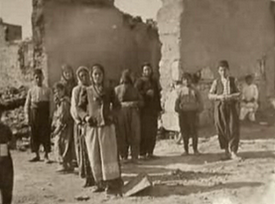
An Armenian town pillaged and destroyed during the Adana massacre.
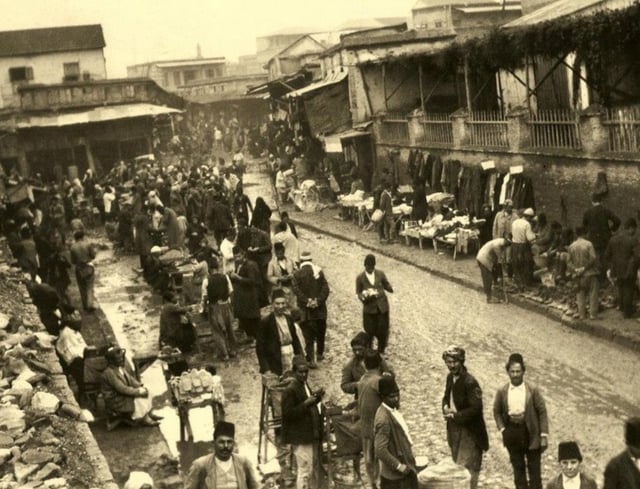
Adana in 1921
From the early modern period to the modern era (1517–1918), the Ottoman Empire ruled the area. In the 1830s, in order to secure Egypt's independence from the Ottomans, the army of Muhammad Ali Pasha, the vali of Ottoman Egypt and Sudan, invaded Syria on two occasions, and reached the Adana plain. The soldiers of Muhammad Ali Pasha destroyed Adana Castle and the walls. The subsequent peace treaty secured Egypt's independence, but (at the insistence of Great Britain, Austria, Russia and Prussia) required the evacuation of all Egyptian forces from Syria, and its return to Ottoman sovereignty. In the aftermath, Adana was established as a province in its own right.
The Adana massacre occurred in the Ottoman Vilayet of Adana in April 1909. A religious-ethnic clash in the province amid governmental upheaval led to a series of anti-Armenian pogroms throughout the region.[19] Despite official denial, which placed the blame squarely on the Armenians and the death count at a mere 1500, the massacres in the entire province of Adana resulted in the deaths of roughly 25,000 Armenians.[20] The massacre left around 3500 Armenian children homeless, some being placed in a newly-built orphanage, Dârüleytâm. During World War I in 1915, Ottoman troops deported the city's Armenian population (approx. 20,000[21]) to Syria under the course of Armenian Genocide.
After World War I, the Ottoman government surrendered control of the city to French troops, and the four battalions of the French Armenian Legion were sent to occupy Adana and oversee the repatriation of Armenian refugees. The French forces were, however, spread too thinly in the region and, as they came under withering attacks by Muslim elements both opposed and loyal to Mustafa Kemal Pasha, eventually reversed their policies in the region. The Armenian Legion was gradually disbanded, the repatriation was halted, and the French ultimately abandoned all pretensions to Cilicia, which they had originally hoped to attach to their mandate over Syria.[22] On 20 October 1921, the Treaty of Ankara was signed between France and the Turkish Grand National Assembly. Based on the terms of the agreement, France recognized the end of the Cilicia War, and French troops together with the remaining Armenian volunteers withdrew from the city on 5 January 1922.[23]
On 30 January 1943, British prime minister Winston Churchill secretly met with Turkish president İsmet İnönü inside a train wagon at Yenice Station, 23 kilometres (14 miles) outside of Adana (the so-called Adana Meeting or Adana Conference). Churchill wanted Turkey to join the Second World War on the side of the Allies; the details of which were later discussed at the Second Cairo Conference in December 1943, which was attended by İnönü, Churchill and Roosevelt.
The city was hit by a 6.2 magnitude earthquake (1998 Adana–Ceyhan earthquake) on 27 June 1998. The disaster killed 145 and left 1500 people wounded and many thousand homeless in the city. The total economic loss was estimated at about US$1 billion.[24]
Chronology
Luvi Kingdom (1900 BC), Hittite Empire (1900–1200 BC), Assyrian Empire (713–663 BC), Persian Empire (550–333 BC), Hellenistic (333–323 BC), Seleucid Empire (312–133 BC), Pirates of Cilicia (178–112 BC), Romans (112–95 BC and 55 BC – 395 AD), Armenian Kingdom under the reign of Tigranes the Great (95–55 BC) Byzantines (395–638; 964–1071), Abbasids, Great Seljuq Empire, Armenian Kingdom of Cilicia (1078–1359), Mamluks, Ramadanid Principality, Ottoman Empire, Republic of Turkey.
Governance
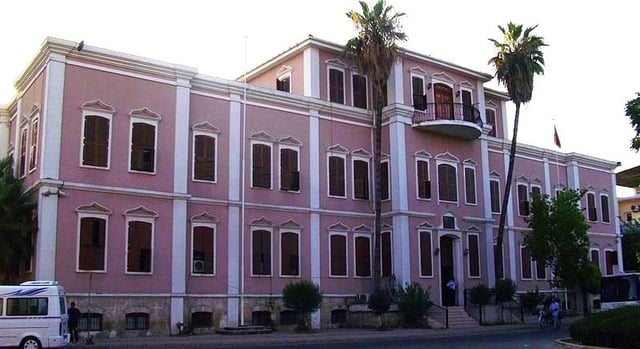
Former City Hall
The city of Adana is referred as the area that is within the borders of Adana Metropolitan Municipality.
This area covers 30 km (18.64 mi) around the City Hall excluding the areas out of the Province.[25] Four levels of government are involved in the administration of the city; national government, provincial administration, metropolitan municipality and the district municipalities.
Government of Turkey in Ankara holds most of the power; health, education, police and many other city related services are administered by Ankara through an appointed Governor. National government is also the lawmaker, adjudicator and auditor of all the other levels of government and the neighborhood administration. Semi-democratic provincial governing body, Adana Province Special Administration, has minor powers, dealing mainly with construction and maintenance of primary schools, daycares and other state buildings and some level of social services.[26] Municipal governance is held in a two-tier structure; Metropolitan Municipality forms the upper and the district municipalities form the lower tier. Metropolitan municipality takes care of construction and maintenance of major roads and parks, operating local transit and fire services.[25] District municipalities are responsible for neighborhood streets, parks, operating garbage collection and cemetery services. The district municipalities are further divided into neighborhoods(mahalle), the smallest administrative units of the city.
Metropolitan municipality
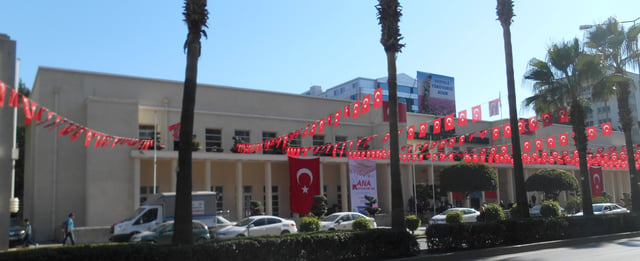
Metropolitan Hall
Adana Municipality was incorporated in 1871 though the city continued to be governed by the muhtesip system until 1877 by the first mayor Gözlüklü Süleyman Efendi. The first modern municipal governance began with the second mayor Kirkor Bezdikyan and his successor Sinyor Artin. The roads were widened and paved with cobblestone, drainage canals and trenches were opened, more importantly the first municipal regulations were put in effect. After the foundation of the republic, major infrastructure projects were completed and the first planned neighborhoods were built north of the city. Turhan Cemal Beriker served as mayor and governor for 12 years during this period. With the completion of Seyhan Dam in 1956, the city saw explosive growth when then prime minister Adnan Menderes showed special interest in Adana; he initiated large-scale infrastructure projects like citywide underground sewer systems and rezoning of residential areas into roads and public spaces. From 1984 to the present, the cityscape has seen revolutionary changes with the revitalization of Seyhan river and the construction of large parks and boulevards.[28]
Metropolitan Municipality Law was introduced in 1989 and the municipal governance was split between metropolitan municipality and district municipalities.
Adana Municipality then became the Metropolitan Municipality and two new district municipalities were founded; Seyhan and Yüreğir.
Karaisalı was annexed to the city in 2006, Çukurova and Sarıçam districts were founded in 2008 by the partitioning of Seyhan and Yüreğir districts respectively.
On 3 February 2012, Karataş Municipal Council accepted a motion to amalgamate the municipality with Adana, hence Karataş will become the sixth district of the city after the transition process is completed.[29]
Metropolitan municipality consists of three organs; Metropolitan Council, Mayor and the Encümen.
Each district municipal council elects one-fifth of their members to represent the district at the metropolitan council.
Thus, metropolitan council consists of 35 councilors, ten from Seyhan district, eight from Yüreğir, eight from Çukurova, six from Sarıçam, two from Karaisalı and the metropolitan mayor who is elected directly by the voters.[30] Encümen, the executive committee, consists of ten members, five being metropolitan councilors and the other five are the directors at the metropolitan hall who are appointed to the Encümen by the metropolitan mayor.[31]
Districts
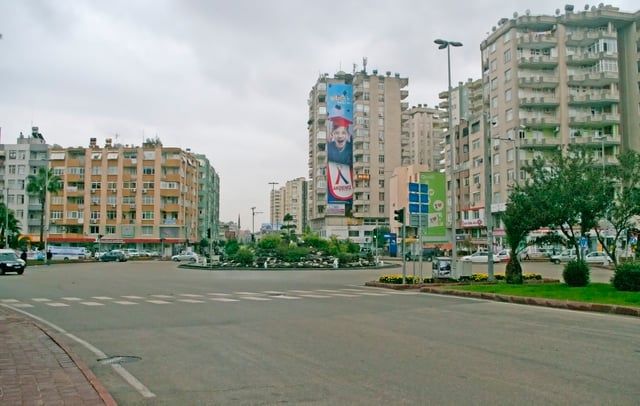
Seyhan district
City of Adana consists of the urban areas of the four metropolitan districts; Seyhan, Yüreğir, Çukurova, Sarıçam.
Seyhan district is fully within the city limits whereas Yüreğir, Çukurova and Sarıçam districts have rural areas outside the city.
Seyhan district, located west of Seyhan River, is the cultural and business center of the city. D-400 state road (also called Turhan Cemal Beriker Boulevard within the city limits) divides the district into north and south. Seyhan's north of D-400, is economically the most developed part of the city. Hotels, cultural centers, commercial and public buildings line up along D-400. Old town, located south of D-400, is the market place where traditional and modern shops serve the residents. South of the old town is a low-income residential area.
Çukurova district, not to be confused with the Çukurova region, is a modern residential district that lies north of the Seyhan district and south of the Seyhan Reservoir. The district was planned in the mid-1980s to direct the urban sprawl to low-fertile 3000 hectare land north of the city. Named as New Adana, the project consisted of 200,000 homes including villas along the lake shore and high-rise apartment buildings along the newly opened wide boulevards of Turgut Özal, Süleyman Demirel and Kenan Evren.[32]
Yüreğir district, located east of the river, consists mainly of low-income residential areas and large-scale industries. With the construction of new bridges on the river and the extension of metro line to the district, Yüreğir became increasingly important, Adana Court of Justice re-locating to the district and a 47.5-hectare health campus planned to be built in the Kazım Karabekir neighborhood.[33] An extensive urban redevelopment plan is under effect in the district which will convert the neighborhoods of Sinanpaşa, Yavuzlar, Köprülü and Kışla into modern residential areas.[34]
District of Sarıçam lies north and east of Yüreğir, consisting of former municipalities that were amalgamated to the City of Adana in 2008. Some of the large institutions of the city are in Sarıçam: Çukurova University, İncirlik Air Base and the Organized Industrial Region.
Neighborhoods
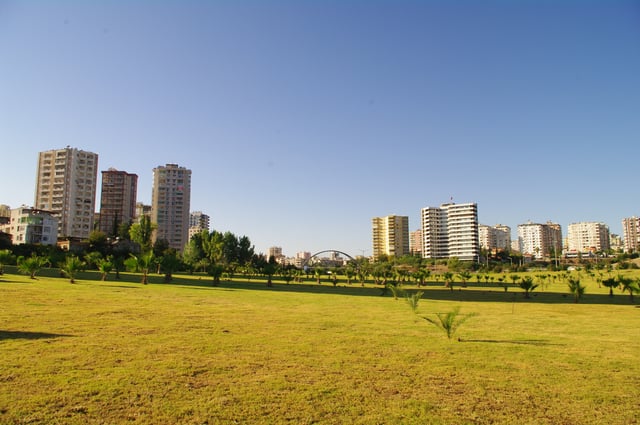
Beyazevler (White Houses) neighborhood
Neighborhoods (Mahalle) are administrative units within the district municipalities and are administered by the muhtar and the Neighborhood Seniors Council. Although elected by the neighborhood residents, the muhtar is not granted any powers, thus functions as an administrator of the national government. Muhtar can voice neighborhood issues to the district municipality and do have a seat at the Adana City Assembly, an umbrella organization for the coordination of public institutions in the city.[35] Despite the fact that neighborhood administration cannot provide social services nor have funding to increase the involvement of residents in neighborhood issues, many residents still like to identify themselves strongly with their neighborhoods especially in the low-income areas.
There are a total of 254 neighborhoods in the city.
Seyhan has 99 neighborhoods, 69 of them in the urban area and 30 are the neighborhoods of the former municipalities and the former villages that converted into neighborhoods. Yüreğir has 99 neighborhoods, 38 in the urban area and 61 rural. There are 29 neighborhoods in Sarıçam, 16 neighborhoods in Çukurova and 11 in Karaisalı district. A neighborhood population can range from 150 to 63,000.[36] Some neighborhoods, especially in the Çukurova district, are very large—almost the size of a town—making resident access to muhtars difficult.
Tepebağ, Kayalıbağ, Kuruköprü, Ulucami, Sarıyakup and Alidede are the historical neighborhoods of Adana. The planned neighborhoods of the republican era, Reşatbey, Cemalpaşa, Kurtuluş and Çınarlı are the core of cultural life in the city. Güzelyalı, Karslılar and Kurttepe are the scenic neighborhoods overlooking the Seyhan reservoir.
Economy
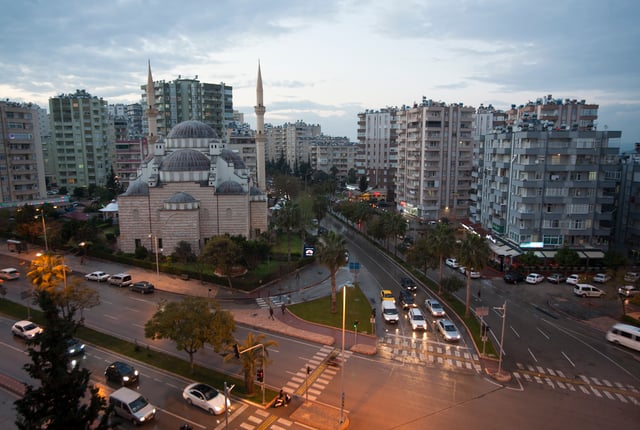
A view of Turgut Özal Boulevard in Çukurova.
Adana is one of the first industrialized cities, as well as one of the economically developed cities of Turkey.
A mid-size trading city until the mid-1800s, the city attracted European traders after the United States, a major cotton supplier, was embroiled with its Civil War. Çukurova farmers exported agricultural products for the first time and thus started building capital. By the start of the 20th century, factories almost all processing cotton, began to operate in the region. Factories were shut down and the economy almost came to a standstill in 1915, after the genocide of Armenians who ran most of the businesses in the city. Foundation of the republic, again accelerated the growth of industrialization by re-activation of closed plants and opening of state-owned ones. With the construction of Seyhan Dam and improvements in agricultural techniques, there was an explosive growth in agricultural production during the 1950s. Large-scale industries were built along D-400 state road and Karataş road. The service industry, especially banking, developed during this period.[37] Rapid economic growth continued until the mid-1980s and was accompanied by the rise of capitalistic greed which attracted movie makers to the region, filming income inequalities and the abuse of wealth.
Extensive neo-liberal policies by then Prime Minister Turgut Özal to centralize the country's economy, caused almost all Adana-based companies to move their headquarters to Istanbul. The decline in cotton planting in the region raised the raw material cost for manufacturing, thus the city has seen a wave of plant closures starting from the mid-1990s.[38] Young professionals fled the city, contributing to Adana's status as the top brain drain city of Turkey. Financial and human capital flight from Adana further increased since 2002 with the current national governing party, AKP, due to neo-liberal centralization policies similar to Özal's and in addition, hidden policy not to invest in major projects in a city nonaligned with AKP version of conservatism. In 2010, unemployment in the city reached a record high of 19.1 percent.[39] After 20 years of stagnation, the economy of Adana is picking up recently with investments in the tourism and service industry, wholesale and retail sectors and the city is re-shaping as a regional center.
Adana was named among the 25 European Regions of the Future for 2006/2007 by Foreign Direct Investment magazine. Chosen alongside Kocaeli for Turkey, Adana scored the highest points for cost effectiveness against Kocaeli's points for infrastructure development, while Adana and Kocaeli tied on points for the categories of human resources and quality of life.[40]
Commerce

ATO facility at Dilberler Sekisi
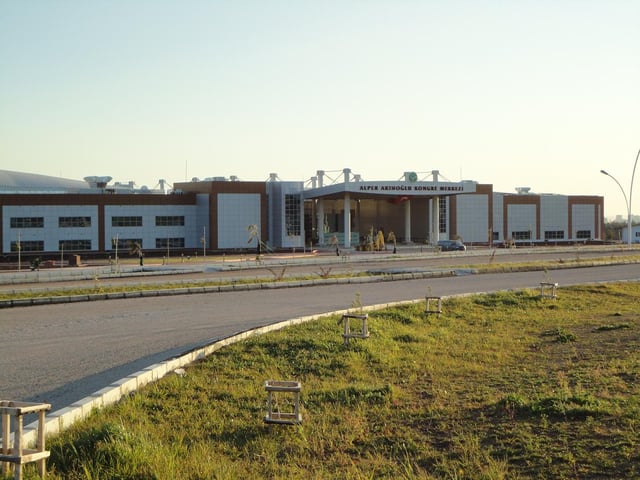
Alper Akınoğlu Congress Center
A leading commercial center in southern Turkey, the city hosts regional headquarters of many corporate and public institutions.
TÜYAP Exhibition and Congress Center hosts fairs, business conferences and currently it is the main meeting point for businesses in Çukurova.[41] Academic oriented 2000-seater Alper Akınoğlu Congress Center is expected to open in 2012 at Çukurova University campus.[42]
Adana Chamber of Commerce (ATO) was founded in 1894 to guide and regulate the cotton trade and it is one of the oldest of its kind in Turkey. Today the Chamber has more than 25,000 member companies, furthers the interests of businesses and advocates on their behalf.[43] Adana Commodity Exchange, founded in 1913, functions mainly to organize the trade of agricultural produce and livestock in a secure and open manner. The Exchange is located across the Metropolitan Theatre Hall.[44]
Designation of coastal areas of Ceyhan and Yumurtalık districts as Energy-specific Industrial Areas has made Adana an attraction for hotel building. Current capacity of 29 hotels hosting 4200 guests will double in two years; total number of hotel beds rising to 8400.[45] Current 5-star hotels of the city, Hilton, Seyhan and Sürmeli will be complemented by Sheraton and Türkmen hotels on the river bank, Ramada and Divan hotels in the city center, Anemon hotel at the west end which are all currently under construction.[46]
Agriculture
Adana is the marketing and distribution center for Çukurova agricultural region, where cotton, wheat, corn, soy bean, barley, grapes and citrus fruits are produced in great quantities.
Farmers of Adana produce half of the corn and soy bean in Turkey. 34 percent of Turkey's peanuts and 29 percent of Turkey's oranges are harvested in Adana.[47] Most of the farming and agricultural-based companies of the region have their offices in Adana.
Producer co-operatives play a significant role in the economy of the city.
Çukobirlik, Turkey's largest producer co-operative, has 36,064 producer members in ten provinces and services from planting to marketing of cotton, peanut, soybean, sunflower and canola.[48]
Adana Agriculture Fair is the region's largest fair attracting more than 100 thousand visitors from 20 nations. The fair hosts agriculture, livestock, poultry and dairy businesses. Greenhouse and Gardening Fair also takes place at the same time in part of the Agriculture Fair. The fair is organized on a 3.5-hectare area at TÜYAP Exhibition Center every year in October.[49]
Manufacturing
Adana is an industrialized city where large-scale industry is based mostly on agriculture.
Food processing and fabricated metal products are the major industries constituting 27 percent of Adana's manufacturing,[50] furniture and rubber/plastic product manufacturing plants are also numerous.
As of 2008, Adana has 11 companies in Turkey's top 500 industrial firms.[51] The largest company in Adana, Temsa Global, an automotive manufacturer, has more than 2500 employees and manufactures 4000 buses annually. Marsan-Adana is the largest margarine and plant oil factory in Turkey.[52] Advansa Sasa is Europe's largest polyester manufacturer employing 2650.[53] Organized Industrial Region of Adana has an area of 1225 hectare with 300 plants, mostly medium-scale.
Demographics
As of December 2018, the total population of the four districts is 1,747,567.[54]
The population of the four districts of Adana since 2008 are:
| District | City Population | |||||||||
|---|---|---|---|---|---|---|---|---|---|---|
| 2008 | 2009 | 2010 | 2011 | 2012 | 2014 | 2015 | 2016 | 2017 | 2018 | |
| Seyhan | 752,308 | 722,852 | 723,277 | 757,928 | 764,714 | 779,232 | 788,722 | 797,563 | 800,387 | 793,480 |
| Yüreğir | 411,299 | 415,047 | 417,693 | 421,692 | 416,302 | 419,240 | 419,011 | 419,902 | 424,999 | 415,198 |
| Çukurova | 267,453 | 327,460 | 343,770 | 326,938 | 335,733 | 353,680 | 359,315 | 362,351 | 364,118 | 365,735 |
| Sarıçam | 86,727 | 90,879 | 99,313 | 103,232 | 111,976 | 143,547 | 150,425 | 156,748 | 163,833 | 173,154 |
| Total | 1,517,787 | 1,556,238 | 1,584,053 | 1,609,790 | 1,628,725 | 1,695,699 | 1,717,473 | 1,736,564 | 1,753,337 | 1,747,567 |
Two-thirds of the residents of Adana live west of the Seyhan River, where the city was first founded.
Urban sprawl east of the river is limited due to large institutions such as Çukurova University and Incirlik Air Base.
Seyhan is the most diverse district, accommodating all ethnic groups.
The major ethnic groups in Adana are the Turks, followed by Arabs and Kurds.
Population growth slowed between 1885 and 1927 because of the Adana Massacre and the Armenian deportations, with the numbers only being replenished, rather than increased, by refugees brought in from the Balkans as part of the Population Exchange of 1923. The first Turks moved to the city from Central Asia around the 11th century. In the early 14th century, several Türkmen tribes were settled after Mamluks took control of Çukurova.[55] An Ottoman tax register from 1526 records 16 Turkish residential areas, but only one Armenian and none that were Greek, Jewish, Kurd or Arab.[56] During the 17th century more Armenians and Greeks settled in the city; according to Evliya Çelebi there was also an Arab population.[56]
| Historical population | ||
|---|---|---|
| Year | Pop. | ±% |
| 1885 | 69,266 | — |
| 1927 | 72,577 | +4.8% |
| 1955 | 100,367 | +38.3% |
| 1980 | 574,515 | +472.4% |
| 2000 | 1,130,710 | +96.8% |
| 2018 | 1,747,567 | +54.6% |
Arabs are concentrated in Karşıyaka quarter of Yüreğir. New generations of Arabs do not speak Arabic as they are mostly assimilated into Turkish culture. The demography of the city changed significantly in the 1990s after the massive migration of Kurds, many of them being forced to leave their villages in the southeast at the peak of Turkey–PKK conflict.[57] Kurds mostly live in southern neighborhoods of the city.[58] Conos, a tribe of Romani people of Romania, settled in Adana during the Balkan Wars. Conos mainly live around Sinanpaşa neighborhood. Around 8,000 Romani people live in Adana Province, including Conos.[59] There is a sizeable community of migrants from the Balkans and Caucasia, who also settled in Adana during the Balkan Wars and before.
An estimated 2,000 families of Crypto-Armenians live in Adana, identifying themselves as Arabs, Kurds or Alevis for the last century.[60] There is still an active Armenian Catholic Church in the Old Town, built in 1909. In addition, there are a large number of descendants of the Armenian children given to Muslim families to be fostered in 1915, either by their Armenian parents or by Ottoman officials. Armenians and Greeks constituted half of the population of Adana before 1915.[61]
Similar to other cities on the Mediterranean and Aegean coasts, secularism is strong in Adana. Among the people with faith, the majority of the residents adhere to Sunni Islam. The majority of Turks, most of the Kurds and some of the Arabs are Sunni Muslim. Adana is also a stronghold of Alevism, many Alevis having moved to the city from Kahramanmaraş after the incidents in 1978. Arabs of Adana are mostly Alawi, which is often confused with Alevis. Alawi Arabs are locally known as Nusayri or Fellah. Arabs from Şanlıurfa Province are Sunni Muslims. There is a tiny community of Roman Catholics and a few Jewish families.
Cityscape
Architecture
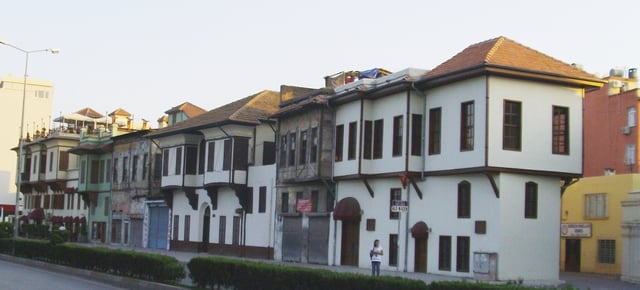
Historic rowhouses, Tepebağ.
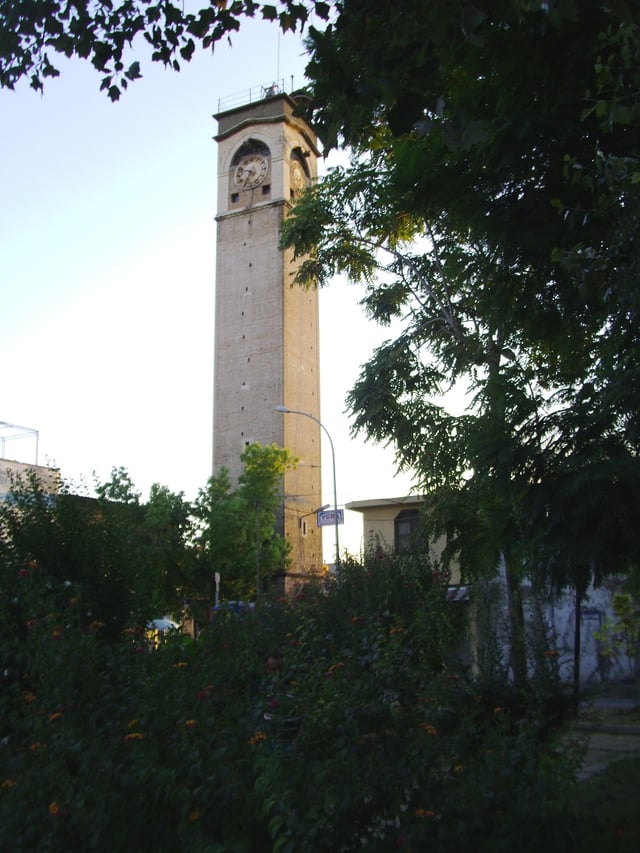
The Great Clock Tower
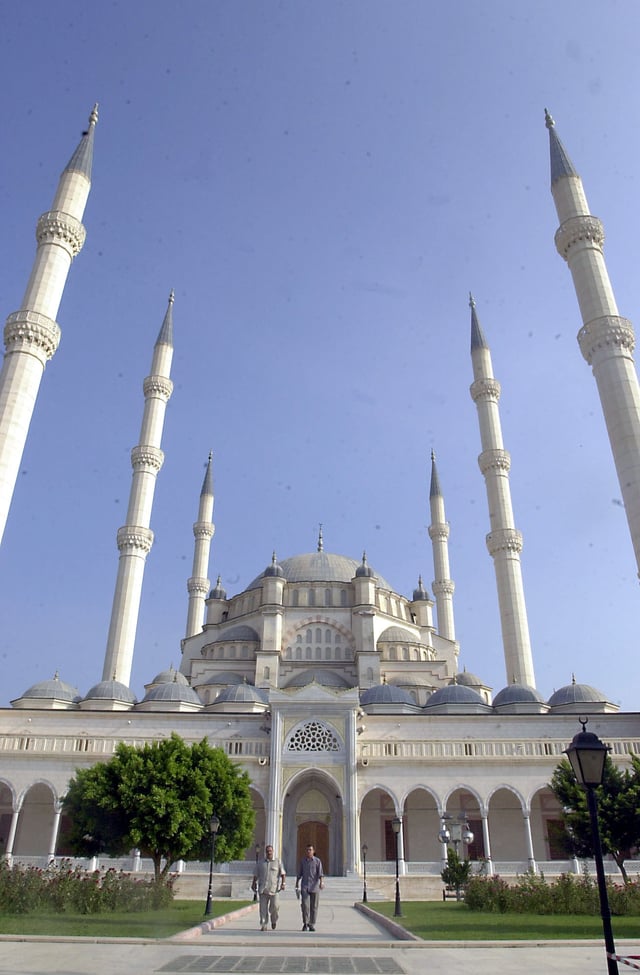
Sabancı Central Mosque
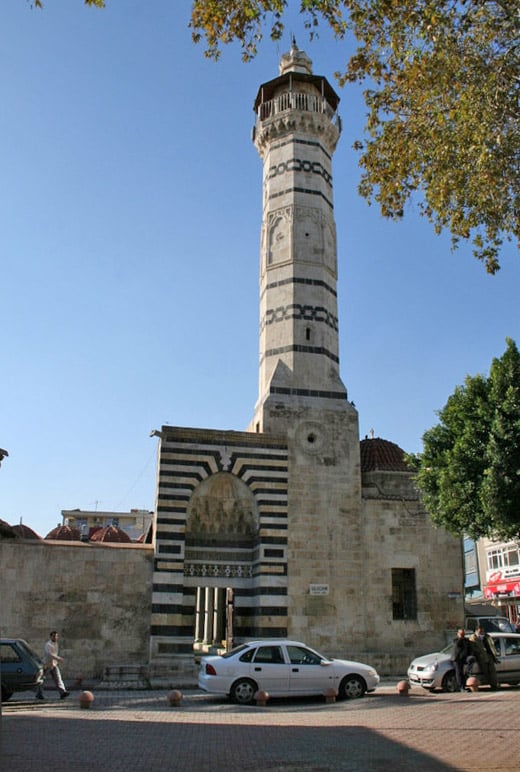
Ulu Cami

Saint Paul Church (Bebekli Kilise)
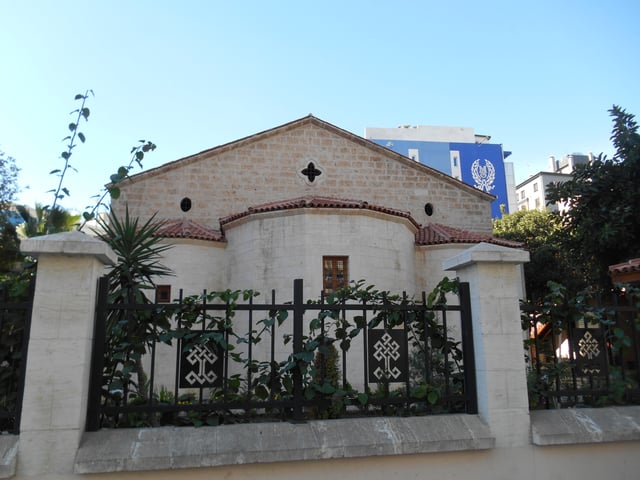
Kuruköprü Church
The golden age for the architecture of Adana was the late 15th and 16th centuries when Ramadanid principality chose Adana as their capital. The city grew rapidly during that period with many new neighborhoods being built. Most of the historical landmarks of Adana were built during this period, thus Mamluk and Seljuqid architecture are dominant in Adana's architectural history. Taşköprü is the only remaining landmark from the Roman-Byzantine era, and few public buildings were built during Ottoman rule. Adana is home to modern Turkey's historic Armenian architecture, which can be found behind the city's central modern buildings.
The first traces of settlement in the quarter of Tepebağ, can be traced to the neolithic age. The quarter is next to the Taşköprü stone bridge, situated on a hill which gave its name Tepebağ (Garden on the hill). The city administration has launched a campaign to preserve the heritage of this area, particularly the Ottoman houses. Atatürk stayed in one of these houses on Seyhan Caddesi which now houses the Atatürk Museum.
Several bridges cross the Seyhan river within the city, the most notable among them is the Taşköprü, a 2nd-century Roman bridge.[63] Currently used by pedestrians and cyclists, it was the oldest bridge in the world to be open to motorized vehicles until 2007. Demirköprü is a railway bridge that was built in 1912 as part of the Berlin-Baghdad Railway project. Regülatör bridge, at the southern section of the city, is a road bridge as well as a regulator for the river water. There are also three footbridges, Seyhan and Mustafakemalpaşa road bridges, the bridge of the metro and the bridge of the motorway spanning the river.
Büyük Saat (The Great Clock Tower), built by the local governor of Adana in 1882, is the tallest clock tower in Turkey rising 32 m (104.99 ft) high. It was damaged during French occupation, but was rebuilt in 1935, and its image can be found in the city's coat of arms. Kazancılar Çarşısı (Bazaar of Kazancilar), founded around the Büyük Saat.
Ramazanoğlu Hall was built in 1495 during the reign of Halil Bey. A three-story building, made of stone and brick, it is one of the oldest examples of a house in Turkey. This hall is the Harem section, where the Ramadanid family lived. Selamlık section, where the government offices were, no longer exists.
Çarşı Hamam (Turkish bath of the Bazaar) was built in 1529 by Ramazanoğlu Piri Pasha and it is the largest hamam in Adana. It is built with five domes and the inside is covered with marble. During the time it was built, water was brought from Seyhan River by water wheels and canals.[64]
Irmak Hamam (Turkish bath of the River), located next to Seyhan District Hall, was built in 1494 by Ramazanoğlu Halil Bey on the ruins of an ancient Roman bath. Its water comes from the river. Other historical hamams in the city are Mestenzade Bath and Yeni Bath.
Mosques
Sabancı Merkez Camii, though not being historical, is the most visited mosque in Adana, as it is one of the largest mosques in the Middle East. Built in loyalty to Ottoman Architecture, the mosque was opened in 1998 to a capacity of 28,500 prayers. The mosque has six minarets, four of them being 99 meters high. Its dome has a diameter of 32 meters and is 54 meters above the praying area. It is located on the west bank of Seyhan River at the corner of Seyhan Bridge and can be seen from a wide area.[65]
Ulu Cami, a külliye built in 1541 during Ramadanid era, is the most interesting medieval structure of Adana with its mosque, madrasah and türbe. The mosque is of black and white marble with decorative window surrounds and it is famous for the 16th century Iznik tiling used in its inner space. The minaret is unique with the Mamluk effects it bears and with its orthogonal plan scheme.
Yağ Camii was originally built as the Church of St. James, then converted into a mosque by Ramazanoğlu Halil Bey in 1501.[66] His successor Piri Mehmet Paşa added its minaret in 1525 and its madrasah in 1558. It is in the Seljuqid Grand Mosque style and has an attractive gate made of yellow stone.
Yeni Camii (New Mosque) was built in 1724 by Abdülrezzak Antaki, and is still known as Antaki Mosque by some. The influence of Mamluk architecture is visible. It is built in rectangular order and has an interesting stonework on its south walls.[67]
Alemdar Mescidi, Şeyh Zülfi Mescidi, Kızıldağ Ramazanoğlu Mosque, Hasan Aga Camii (16th Century wooden architecture constructed without nails) are some other mosques having historical value.
Churches
In the 19th century, the city had four churches; two Armenian, one Greek and one Catholic.
Saint Paul Church (Bebekli Kilise) is a Roman Catholic church that was built in 1870. It is located in the old town, close to 5 Ocak Square and currently serves the Roman Catholic and the Protestant communities.
Agios Nikolaos Greek Orthodox Church was built in 1845 in the Kuruköprü area and was converted into a museum in 1950.
The church was restored to its original state and purpose in 2015 and is renamed Kuruköprü Monumental Church.
Armenian Church on Ali Münif Street, at midpoint between Yağ Camii to Büyüksaat, was converted into a Ziraat Bank branch during the Republican Era. Surp Asdvadzadzin Armenian Apostolic Church on the Abidinpaşa Street which served until 1915, was used as a movie theatre until 1970, and then demolished by the government and the Central Bank (Merkez Bankası) regional headquarters was built in its stead.[68]
Parks and gardens
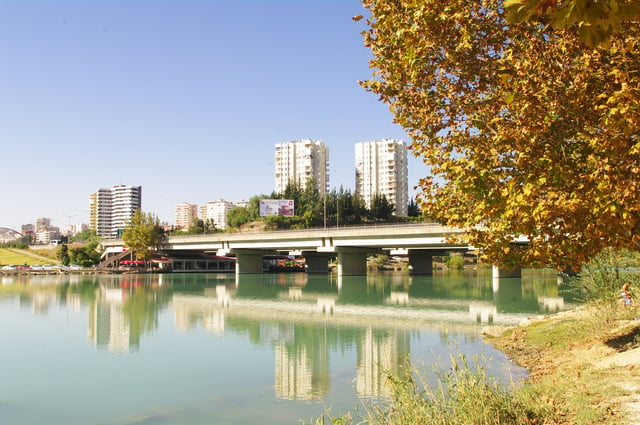
Dilberler Sekisi Park
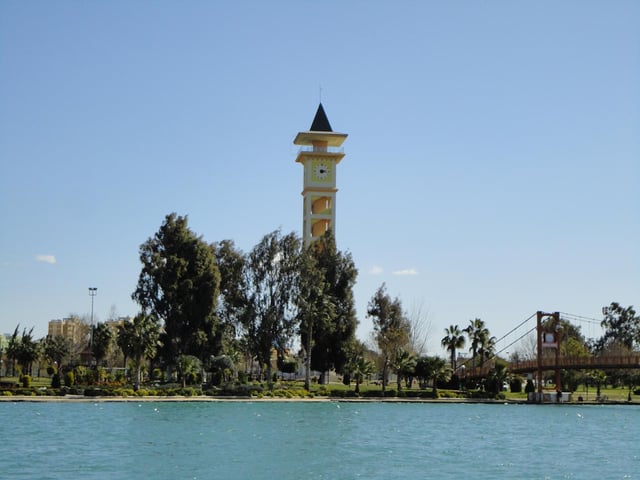
Clock Tower at Merkez Park
Adana has many parks and gardens.[69] Owing to the warm climate, parks and gardens are open all year long without the need of winter maintenance.
Recreational pathways on both banks of Seyhan river cross the entire city from south end to Seyhan Reservoir.
Pathway then connects to Adnan Menderes Boulevard which follows the southern shores of Seyhan Reservoir, and the wide sidewalks of the boulevard extend the pathway to the west end of the reservoir.
Dilberler Sekisi is the most scenic part of the pathway which is along the west bank, in between the old and the new dam. Recreational pathway along the north side of the Grand Canal goes from east end to west end of the city, crossing Seyhan river from old dam's pathway. Some sections of this pathway have not yet been completed. Once completed, within the city there will be almost 30 kilometres (19 miles) of continuous recreational pathway connecting several parks.
Merkez Park (Central Park) is a 33-hectare urban park that is located on both banks of Seyhan river, just north of Sabancı Mosque. With a 2100-seater amphitheatre, a Chinese Garden, and two cafes, it is the main recreational area of the city. In the park, there is a Rowing Club which serves recreational rowers.
Süleyman Demirel Arboretum is a large botanical garden containing living collections of woody plants intended partly for the scientific study of Çukurova University researchers. The arboretum is also used for educational and recreational purposes by city residents. 512 species of plants exist in the arboretum.[70]
Atatürk Park is a 4.7-hectare city park built during the first years of the Republic. It is centrally located in the commercial district. The park holds a statue of Atatürk and hosts public ceremonies.
Çobandede Park is a 16.5-hectare park at the west shore of Seyhan Reservoir. It is situated on a hill overlooking the reservoir. The park has the tomb of Çoban Dede, a wise man from Karslı Village.
Yaşar Kemal Woods is a hiking area on the east bank of Seyhan river across Dilberler Sekisi. It is dedicated to Çukurova native writer Yaşar Kemal. Çatalan Woods is a large recreational area between Çatalan and Seyhan reservoirs, north of the city, in the Karaisalı district.
Society and culture
One of the major elements that define the society of Adana is the agriculture-based living and its extension, agriculture-based industrial culture.
However, developments in industrial life, improvements in transportation, effects of communication and massive migrations have affected the unique culture of Adana.
Similar to other cities in Turkey, the culture in some sections in the city are very distinct from each other.[71]
Cuisine
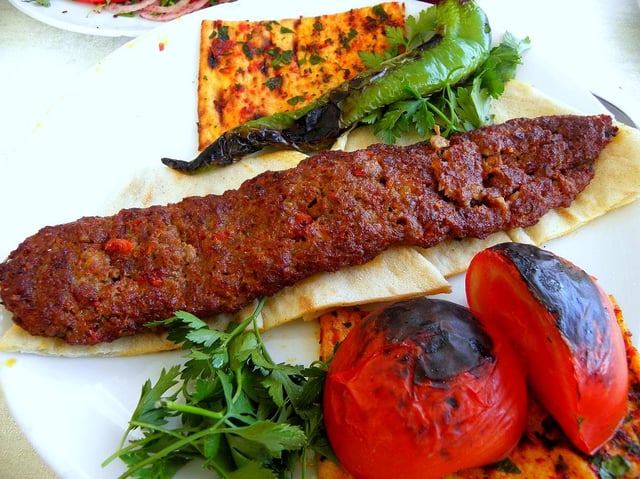
Adana Kebab
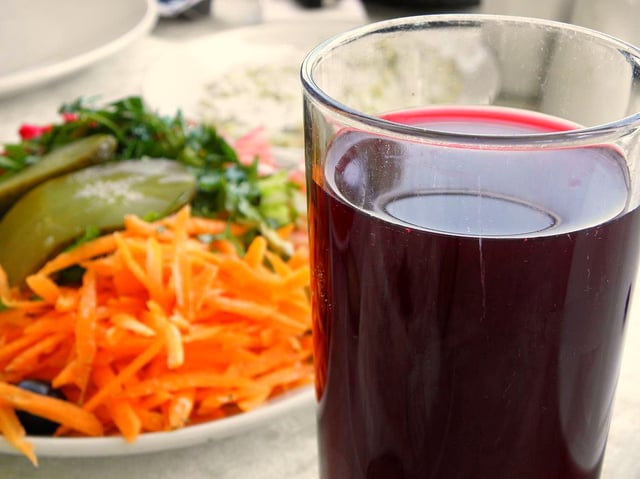
A glass of Şalgam
Adana cuisine is influenced mainly from Yörük, Arabic and Armenian cuisine and the city has kept up its traditions.
Spicy, sour and fatty dishes made of meat (usually lamb) and bulghur are common. Bulghur and flour are found in all Çukurova kitchens. In almost every home, red pepper, spices, tahini, a chopping block and pastry board can be found. The bulghur used in cooking is specific to Adana, made from dark colored hard wheat species with a preferred flavor.[72]
Adana Kebab, called "Kebap" locally, is a kebab made from minced meat. Since it can be found at all kebab restaurants in Turkey and at most Turkish restaurants around the world, the Adana name still suggests kebab to many people. Adana Kebab is the most popular dining choice in Adana, although foods from other cultures are becoming increasingly popular. Besides many kebab restaurants, there are also many kebab serving vendors in the older streets of Adana.
Adana Kebab is usually served with onion salad, green salad or with well-chopped tomato salad.
Rakı and Şalgam usually accompany it as drinks. There are many varieties of salads typical to the city. Radish salad with tahini is popular and it is found only in the Çukurova region. Şalgam and pickle juice are the drinks of the winter and aşlama (licorice juice) is the choice of drink in summer.
One of the famous sweets of Turkey called "Sweet Sausage" originated from Adana.
It was invented by Sir Duran O. during the First World War, around 1915 Seker Sucugu.
Vegetable dishes are also popular in the city.
Besides tomato paste, pepper paste is used in almost every dish.
The city is also famous for its Şırdan a kind of home-made sausage stuffed with rice, and eaten with cumin; paça, boiled sheep's feet; bicibici (pronounced as bee-jee-bee-jee) made from jellied starch, rose water and sugar is served with crushed ice and consumed especially in summertime. Furthermore, the city has a number of famous desserts, such as Halka Tatlı, a round-shaped dessert, and Taş Kadayıf, a bow-shaped dessert. Several types of fruit, including the apricot, are native to this area.
Arts and entertainment
Performing arts
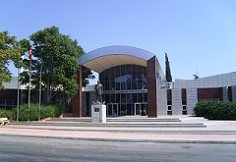
Sabancı Cultural Center
Çukurova State Symphony Orchestra performed its first concert in 1992 and since then, the orchestra performs twice weekly from October to May at the Metropolitan Theatre Hall. The orchestra consists of 39 musicians and conducts regular tours in Turkey and abroad.
Adana State Theater opened its stage in 1981 at the Sabancı Cultural Center. It performs regularly from October to May.[73] Adana Town Theatre was founded in 1880 by governor Ziya Paşa to be the first theater in Adana. In 1926, the theater moved to the newly-built Community Center. Town Theatre currently performs weekly at the Metropolitan Theatre Hall and the Ramazanoğlu Center. Seyhan Town Theatre and Seyhan Folkloric Dances are weekly events at the Theater Hall of Seyhan Cultural Center.
Amphitheaters in Adana host performances from April to November. Mimar Sinan Amphitheater, the largest in Adana, can accommodate 8,000 guests and hosts concerts and movies. It is located at the west bank of the Seyhan River. 2,100-seater Merkez Park Amphitheater, 3,000-seater Çukurova University Amphitheater and Doğal Park Amphitheater in Çukurova District also host theaters, concerts and cinemas. Recently, historic buildings have been restored and converted into cultural centers. The 515-year-old Ramazanoğlu Hall and 130-year-old former high school for girls (now called the Adana Center for Arts and Culture) serve as cultural centers hosting art exhibitions and cultural events.
Museums and art galleries
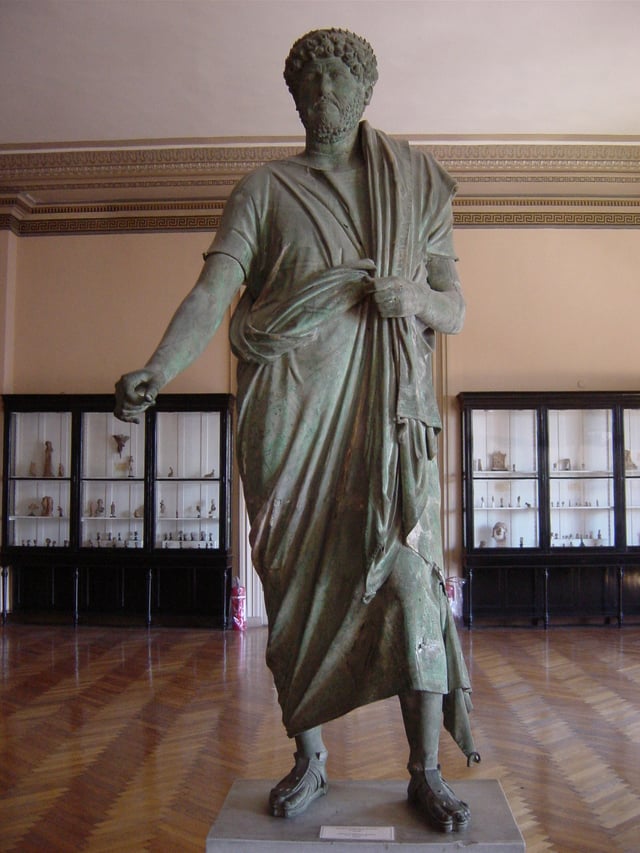
Emperor Hadrian, 2nd century CE
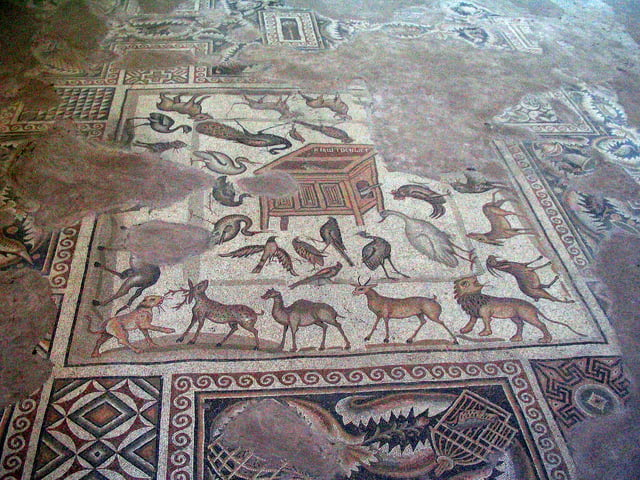
Misis Mosaic Museum
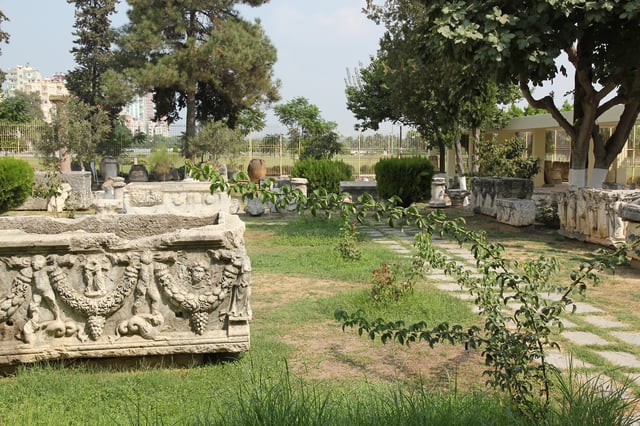
Garden of Adana Archaeology Museum
Adana Archaeological Museum was opened in 1924 as one of the oldest ten museums in Turkey. It moved to its current location at the west corner of Seyhan Bridge in 1972. The museum exhibits archeological works from all over Çukurova. Notable works are the two Augustus statues from Hittites, Achilles Sarcophagus depicting Trojan War and statues from Magarsus and Augusta ancient cities.
Adana Ethnography Museum was opened in 1983 after Archeological Museum moved to its new location. In the front and back yard there are epitaphs and gravestones of Adana's leading figures of the 17th century. In the west yard, there are inscriptions of Taşköprü, Misis Bridge, old City Hall and Bahripaşa Fountain. Inside, there are clothing, jewellery and weaponry of Yörük villagemen.
Atatürk Museum exhibits War of Independence and first years of Republic at the mansion where Atatürk stayed during his trips to Adana.
Misis Mosaic Museum, located on the city's far east end at the west bank of Ceyhan river, exhibits mosaics that were on the floor of a 4th-century temple in the ancient city of Misis. The mosaic depicts Noah and 23 birds and poultry that he took onto the ark during the Flood. The museum also exhibits the works that were excavated from Misis Tumulus.[74]
Karacaoğlan Museum of Literature, Adana Museum of Cinema, Yeşiloba Martyrs' Museum, Mehmet Baltacı Museum of Photography and Adana Urban Museum are other noteworthy museums in the city, many of them located in restored historical buildings.[75] State Fine Arts Gallery was opened in Sabancı Cultural Center in 1982. It carries 59 plastic pieces of art. 75.Yıl Art Gallery in Atatürk Park, Adana City Hall Art Gallery and Art Gallery in Seyhan Cultural Center are the other public art galleries.
Festivals
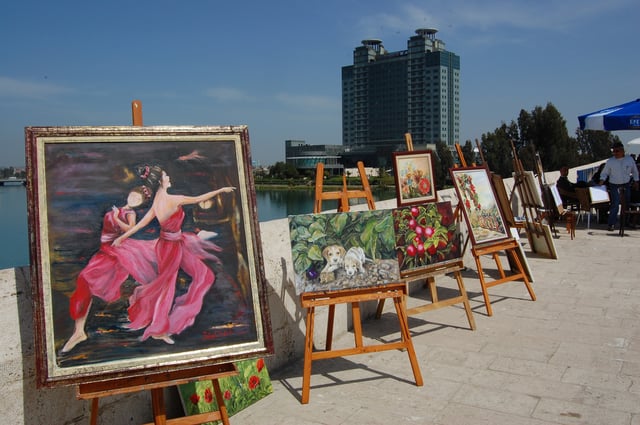
Art Exhibition at Taşköprü during the Sabancı Theater Festival
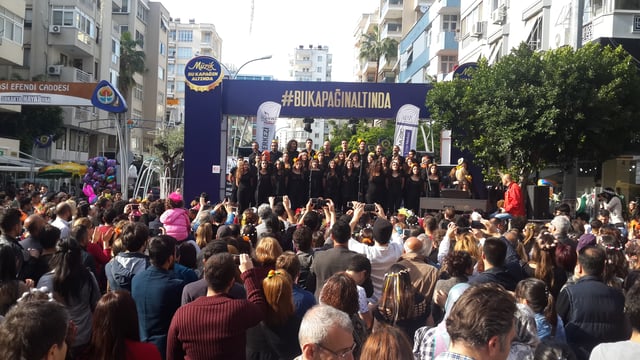
A street concert during the Carnival in 2015
Altın Koza International Film Festival is one of the top film festivals in Turkey, taking place since 1969. During the Altın Koza of 2009, 212 international films were shown in 11 movie theatres across the city. Long Film Contest, International Student Film Contest and Mediterranean Cultures Film Contest are held during the festival.
International Sabancı Theater Festival is held every year in April since 1999. At the festival in 2011, 461 artists from 17 ensembles (10 local and 7 international) performed plays on the stage at the Sabancı Cultural Center. The festival's opening show was staged on the Seyhan River and Taşköprü by Italian ensemble Studio Festi. "Water Symphony" show was greeted by thousands of people with great enthusiasm.[76]
Orange Blossom Carnival is held every April, inspired by the scent coming from the city's orange tree-lined streets. The carnival parade of 2015 attracted more than 90 thousand people—the highest attendance ever in an outdoor event in Adana.[77] Organized concerts and shows in the city's squares, parks and streets are accompanied by spontaneous street celebrations.
International Çukurova Instrumental Music Festival is a two-week long festival held annually in Adana, Antakya and Gaziantep. In 2009, the festival took place for the fifth time with an opening concert from Çukurova State Symphony Orchestra. Baritone Marcin Bronikowski, pianist Vania Batchvarova, guitarist Peter Finger, cellist Ozan Tunca and pianist Zöhrap Adıgüzelzade were some of the musicians who performed at the festival.[78]
13 Kare Arts Festival began in 1999 as a festival of photography dedicated to 13 photographers of Adana who died in an accident during an AFAD (Adana Photography Amateurs Association) trip.
The festival then expanded to include other arts.
During the festival, exhibitions of nature, undersea and architecture photography, puppet shows, shadow theater and several concerts are held.
The festival takes place every December.
Adana Literature Festival is held every April at Adana Center for Arts & Culture. Around 100 writers, poets and critics participate in the festival and give talks, make up panels and make presentations.
Nightlife
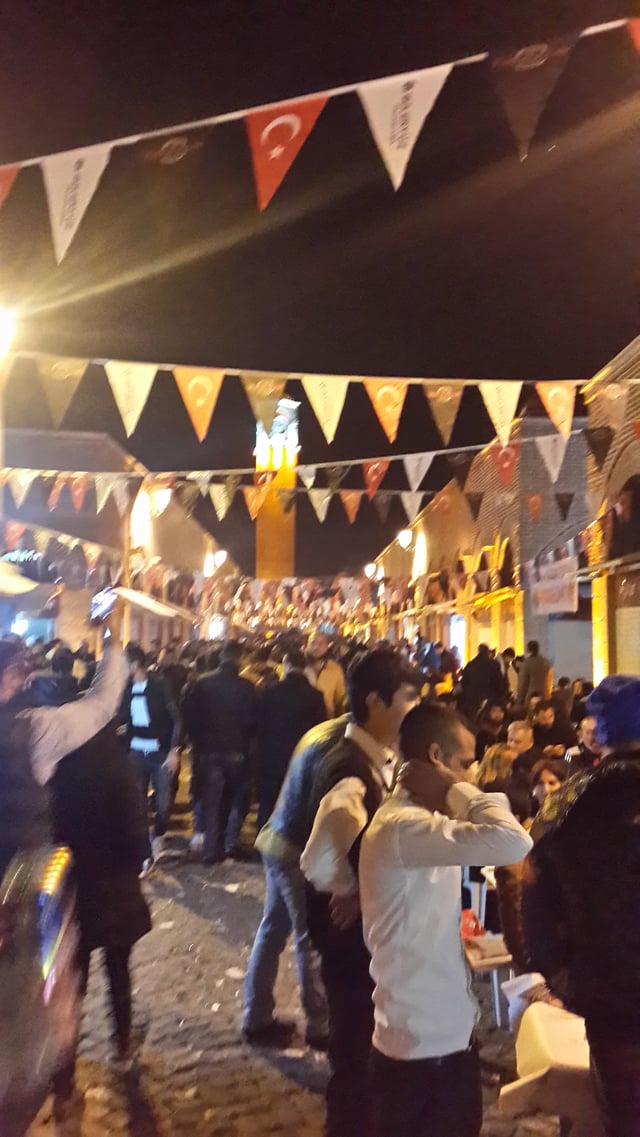
World Rakı Festival
The city was well known for its vibrant nightlife and many pavyons from the 1950s to the 1980s. Although some were family entertainment places, pavyons mostly functioned as adult entertainment clubs, similar to hostess clubs of Japan, with live music, usually two-storey, a stage and a lounge with tables lined up at the main floor and private rooms at the upper floor.[80] The first pavyons opened in the city by 1942 with the arrival of English workers who worked on the Adana-Ulukışla road that was funded by the British Government to persuade Turkey to form a front in World War II.[81] As Çukurova cotton was valued by the early 1950s, the surplus took landowners to the pavyons which opened more and more along the Seyhan river. In the 1960s, rapid industrialization brought more men to pavyons not only from the city, but from a wide region including Istanbul and Ankara, thus Adana was named Pavyon Capital of Turkey. Many popular singers took the stage at and owe their fame to the pavyons of Adana.
Pavyons led the way to Western-style pubs and night clubs by the late 1980s with the socio-economic changes in Adana.
The traditional entertainment district is Sular, near Central Station, but the pubs and clubs nowadays are spread throughout the city.
The bigger clubs such as Life Legend, Uptown, Casara and Lava host world star singers at their elegant locations, mostly along the river and the lake.
There are still two active pavyons, Afrodit and Maksim, but adult entertainment is directed mostly to what is known locally as tele-bars.
Tele-bars are licensed as regular pubs, but function as places where bargirls entertain customers and usually hook with them afterwards.
There are around 20 tele-bars mainly in the city center and around the old dam.[82]
A hundred-year-long tradition of kebab, liver and rakı in the Kazancılar Bazaar, with street music and dances, turned into a festival since 2010, with all-night entertainment. World Rakı Festival, held the second Saturday night of December, attracts more than 20 thousand people to the old town.[83]
Sports

Adana Demirspor panorama
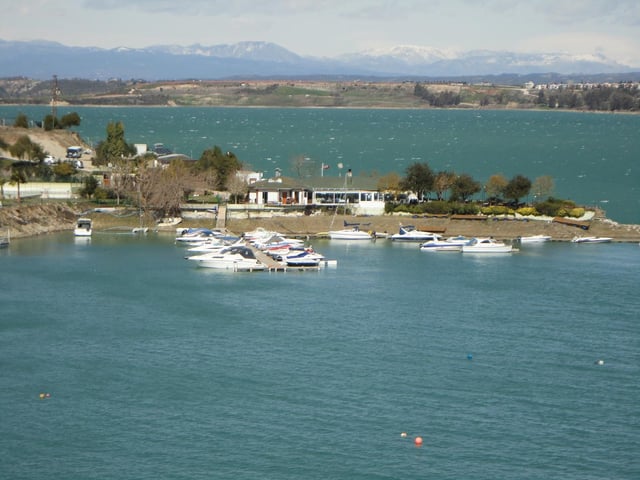
Adana Sailing Club
Football is the most popular sport in Adana; basketball, volleyball and handball are also played widely at professional and amateur levels. Warm weather make the city a haven for sports like rowing, sailing, swimming and water polo. Horse racing and horse riding are also popular. Bi-annual Men's European Wheelchair Basketball Championship took place in Adana on 5–15 October 2009. Twelve countries competed at the event and Italy won the title after a final game against Turkey.[84] Adana also hosted the 2013 IWBF Men's U23 Wheelchair Basketball World Championship.[85] 1967 Women's European Volleyball Championship was organized in Turkey and Adana was a host city together with Istanbul, Ankara and İzmir. Group C games are played in Adana at the Menderes Sports Hall.[86]
| Club | Sport | League | Venue (capacity) | Founded |
|---|---|---|---|---|
| Adanaspor | Football (men) | TFF First League | 5 Ocak Stadium(14,805) | 1954 |
| Adana Demir | Football (men) | TFF First League | 5 Ocak Stadium(14,805) | 1940 |
| Adana İdmanyurdu | Football (women) | First Football League | Gençlik Stadium(2000) | 1993 |
| Kiremithanespor | Football (men) | Turkish Regional Amateur League | Kaynak Kardeşler Stadium (2000) | 1979 |
| Adana Aski | Basketball (women) | Women's Super League | Menderes Sports Hall(2000) | 2000 |
| Adanaspor | Basketball (men) | Basketball Second League | Menderes Sports Hall(2000) | 2006 |
| ABB Şakirpaşa | Handball (women) | Women's Super League | Yüreğir Serinevler Arena(2000) | 2012 |
Adanaspor and Adana Demirspor are the two clubs of Adana that appear in Turkish Professional Football League. After 12 years, Adanaspor returned to Super Lig,[87] in which they had competed for 21 years and were the runner up in 1980–81 season. Adanaspor also performed at the UEFA Cup for three years. Adana Demirspor, currently performing at the TFF First League, was the runner up at the Turkish Cup in 1977–1978 season and performed at the SuperLig for 17 years. Both teams share 5 Ocak Stadium as their venue, and the matches between them are known as the Adana Derby, an archrival atmosphere that is found in only three cities in Turkey. Kiremithanespor of the Yüreğir district, compete at the Turkish Regional Amateur League. In women's football, Adana İdmanyurduspor competes in the First Football League, and plays their home games at the Gençlik Stadium.
Adana ASKİ are the major clubs in Women's Pro-Basketball—both performing in the Turkish Women's Basketball League (TKBL). Adana ASKİ was founded in Ceyhan in 2000, under the name 'Ceyhan Belediyespor', and renamed and moved to Adana in 2014. After the move, the club performed the best season ever (2014–15), playing in the final at the Turkish Women's Cup and semi-final at the TKBL First Division. Adana ASKİ also play their home games at Menderes Sports Hall. Adanaspor, relegated to the third tier of the Turkish Men's Basketball League in 2016,[88] playing their home games at the Menderes Sports Hall. Wheelchair basketball clubs, Adana Engelliler and Martı Engelliler appear in the first division of the Turkish Wheelchair Basketball League, both playing their home games at the Serinevler Sports Hall.
Professional volleyball club Adana Toros was promoted to the top flight of the Turkish Men's Volleyball League on 12 April 2016 at the play-off finals in Bursa.[89] Adana Toros play their homes games at the Menderes Sports Hall.[90] The city's handball club, Şakirpaşa HEM, promoted to the Turkish Women's Handball Super League on 21 April 2016, at the play-off finals in Ankara.[91] The venue of Şakirpaşa is Yüreğir Serinevler Arena.[92]
Water sports have been recreationally and competitively the traditional sports of Adana.
Water polo team of Adana Demirspor is a legend in the community, joining the Turkish Waterpolo League in 1942 after the first modern water sport venue of Turkey, Atatürk Swimming Complex, opened in Adana in 1936. The team has a record 22 years of straight championship title in Turkish Men's Waterpolo League, 17 years of it without losing a game and thus their given name "Unbeatables". Demirspor has a total of 29 championship titles.[93] Rowing became a popular sport in Adana in the last 20 years. Rowing competitions are held all year long on Seyhan River and Seyhan Reservoir. Metropolitan Rowing Club and Çukurova University SK compete at national and international level. Sailing competitions[94] are also held at Seyhan Reservoir all year long. Adana Sailing Club performs at sailing competitions in different categories. In swimming, Erdal Acet of Adana Demirspor is a prominent figure in Adana, who broke the record of swimming Canal La Manche (English Channel) in 9 hours and 2 minutes in 1976. Recreationally, the lack of swimming pools made Seyhan River and the irrigation canals attractive for swimmers who want to cool off from the hot and humid summers. Due to almost 100 people suffocating every year, the Metropolitan Municipality built and opened 41 swimming pools over the last 15 years.[95]
Adana Half Marathon was inaugurated in 2011 on a national level with the participation of 223 athletes. In 2012, the marathon gained IAAF International Marathon status and hosted 610 athletes from 10 nations.[96] The marathon takes place on the first Sunday following 5 January, Adana's independence day. Master Men, Master Women and Wheelchair competitions, as well as 4 kilometres (2 miles) Public Run are held during the event. The racecourse follows the historic streets of Adana and the streets along the Seyhan river.[97]
Adana is one of the cities of Turkey where horse racing is highly popular. Yeşiloba Hippodrome is traditionally one of the four race courses of Turkey, hosting horse racing competitions from October to May. Adana Equestrian Club is the largest center of horse riding in Turkey, hosting national and international competitions.
Contemporary life
Media
Media in Adana runs by national and local agencies.
Çukurova Journalists Union is the umbrella organization for the local media in the region.
There are several newspapers published daily in Adana, the most popular ones being the Yeni Adana, Ekspres, Toros, Bölge and 5 Ocak papers.
Yeni Adana is the oldest newspaper and dates back to 1918.[98] The newspaper played a significant role in the independence movement after the First World War. Most newspapers in Adana serve not only the city but the Çukurova region. Many national newspapers have their regional publishing centers in Adana. Hürriyet publishes a supplement paper, Hürriyet Çukurova, the most popular regional newspaper, that has circulation of 48,000. Sabah's regional supplement paper, Güney, is also published in Adana.
Kanal A is the longest serving TV broadcaster in Adana, Çukurova TV, Akdeniz TV, Koza TV and Kent TV are the other major broadcasters.
There are numerous local radio channels and TRT's Çukurova Radio can be listened to in the city.
Shopping
Çakmak Street is the traditional shopping street that is located in the old town.
Several attempts by the city to designate it as a pedestrianised street was unsuccessful because traffic flow could not be diverted to another street.
There are several historical bazaars around Büyük Saat and Yağ Camii.
Covered markets around Saydam street, Kilis and Mısır bazaars, were once a haven for shopping for quality foreign goods.
Ziyapaşa Boulevard is the street of elegance where expensive brands are located.
The street runs from D-400 state road to the Central Train Station and the shops are concentrated towards the north end.
The streets around Ziyapaşa and the streets of northern Adana, Özal, Demirel and Evren boulevards also have high-end shops.
There are four modern shopping malls in the city.
Galleria was the first to be built in the early 1990s but did not become popular due to administrative issues.
M1 and Carrefour malls were built during the late 1990s at the west end of the city.
Recently opened Optimum Outlet is the first mall east of the river and is also the closest to the city center.
The mall has a view of the river and the Merkez Park.
Education
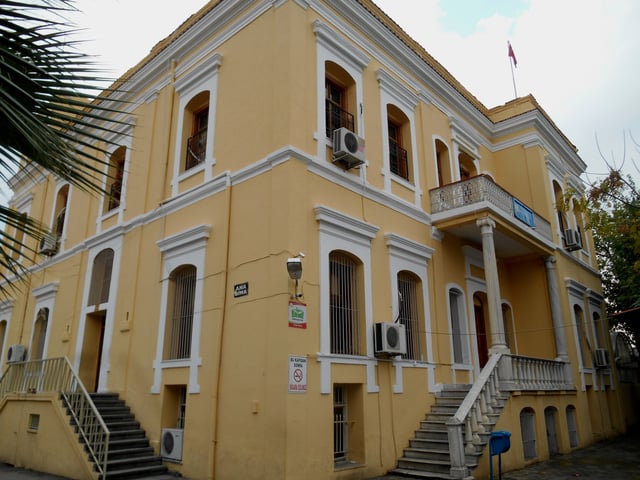
İstiklal High School (A former Greek mansion)

former Adana American College for Girls
Public, private and not-for-profit foundation institutions are located in Adana.
Primary and secondary education in the city is regulated by the provincial directorate of the national Ministry of Education which also administers the state schools.
There are 282 public and 12 private primary schools which pupils attend from grades 1 to 8.
From grades 9 to 11, pupils go to one of the 85 public and 26 private high schools.
Notable high schools of the city that require an examination to enter are the state-owned Adana Fen, Adana Anadolu, and the private Gündoğdu and Bilfen.
Adana Gundogdu Schools is the largest private School in Adana and is increasing in size every year. There are six public and six private schools for pupils with special needs. Nine Community Training Centers support adult residents to improve their skills.[99]
Ramazanoğlu Library was founded in 1923 by combining two smaller libraries.
The library moved to its current location in the Sabancı Cultural Center in 1976 and renamed as Adana Public Library.[100] The library also has a branch in the Karacaoğlan Museum of Literature. Seyhan, Yüreğir, Sarıçam and Karaisalı also have district public libraries administered by each district. Adana City Library is specific on publications about Adana and Çukurova's history, culture and has a good collection of photography and films about the city. City Library is located in the Adana Center for Arts and Culture.[101]
Çukurova Book Fair took place for the fifth time in 2012, hosting 182,450 visitors from Çukurova and neighboring regions. 205 publishers and volunteer organizations had stands, more than 50 cultural events were performed and 300 authors were present to meet the readers. At the same time, Çukurova Education Fair was organized at the Tüyap Exhibition Center with the participation of 45 education institutions.[102]
The city has large ethnic communities and education conducted in unofficial languages is only at institutions that do not get government support.
Few of these institutions teach Arabic and Kurdish in Adana.
The requirement for taking admission tests to high schools, universities and to a career in national public services led to the opening of more than one hundred cram schools (Turkish: dershane) in the city since 1984 which added extra schooling and financial burden to residents.[103]
Universities
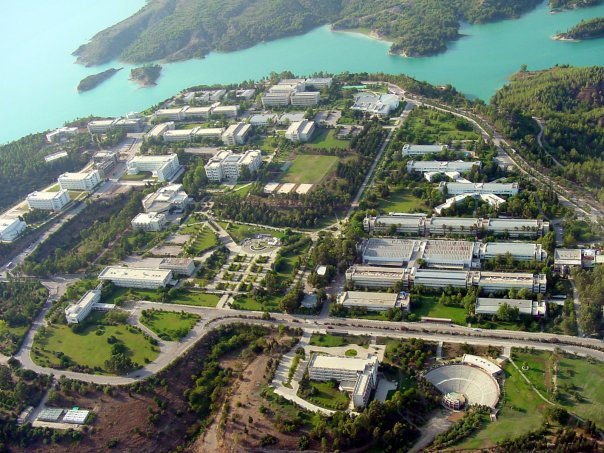
Çukurova University Balcalı Campus
There are two state universities and one foundation university in the city, and there is a second foundation university just outside the city.
Universities are regulated by the Council of Higher Education (YÖK).
Çukurova University is a state university located at the east shores of Seyhan Reservoir. In 2008, with 3 faculties, it is placed among the top 500 universities of the world according to research conducted by Blackwell Publishing, Quacquarelli Symonds and The Times.[104][105] The university was founded in 1973 with the union of the colleges of Agriculture and Medicine. Its campus has many cultural, social and athletic facilities for its 40,000 students.[106]
Adana University for Science and Technology is a recently opened state university that has nine faculties, two institutions and a college.[107]
Çağ University is a not-for-profit tuition-based university founded in 1997. The university is 20 kilometres (12 miles) away from the city center at approximately midway to Tarsus. Most of its 2,500 students commute from Adana, Tarsus and Mersin.
Kanuni University is a recently opened, tuition-based university founded by the Çukurova Education and Culture Foundation.
Healthcare
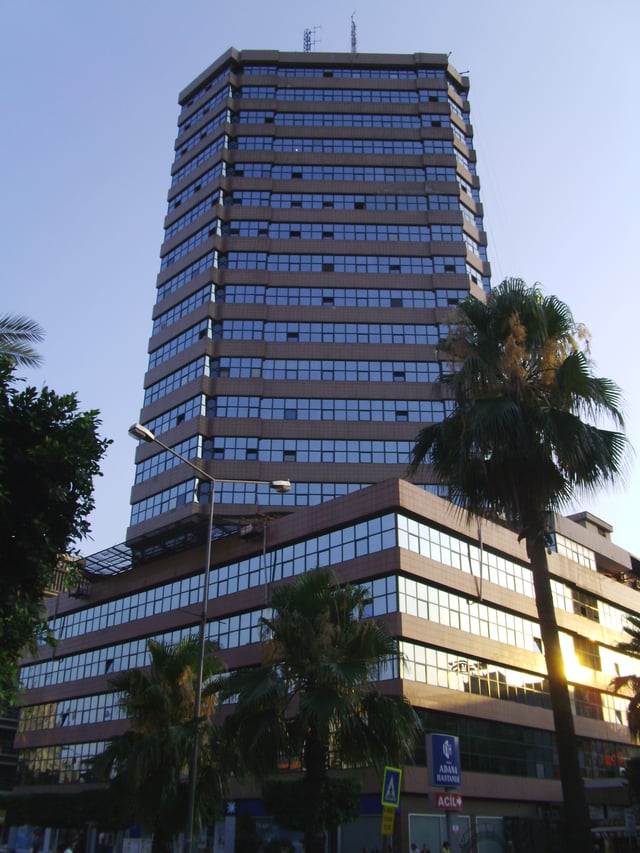
Adana Hospital
Adana is a major health center to a wide region from Mediterranean to Southeastern Anatolia.
There are four university hospitals, eight state hospitals and seven private hospitals in the city.
Hastaneler (Hospitals) area in the Seyhan district is home to hospitals lined up on both sides of the H. Ömer Sabancı Street.
Numune General Hospital, Çukurova State Hospital, Hospital for Thoracic Diseases, Military Hospital and medical centers are healthcare facilities in this area.
Balcalı Hospital of the Çukurova University is a research hospital that was founded in 1987 after the Faculty of Medicine moved to the main campus. The hospital has 1050 inpatient beds in 47 service units, a 58-bed intensive care unit and 17-bed emergency unit. It is the largest hospital in Southern and Southeastern Anatolia and one of the major hospitals of Turkey.[108]
A new health campus is expected to open in Yüreğir by 2014, which will include a 600-bed General Hospital, 200-bed Heart and Stroke Hospital, 250-bed maternity hospital, 100-bed oncology hospital, 150-bed Physiotherapy and Rehabilitation Center, 100-bed Psychiatry Hospital.
The campus will have a capacity of 1400 inpatients in total and will be connected to Hastaneler area of the Seyhan district through a bridge over the Seyhan river which will create one big campus.[109]
Transportation
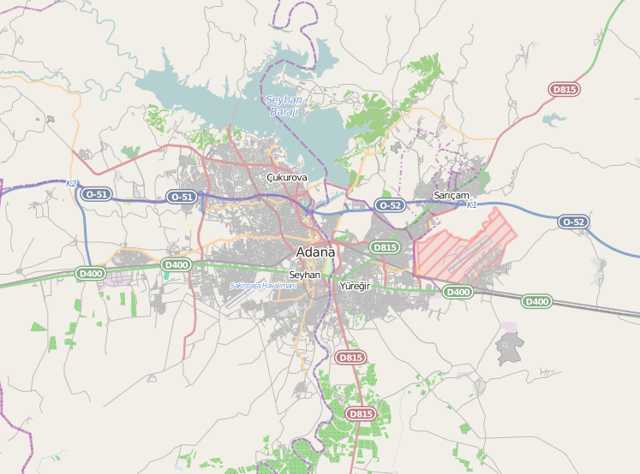
Map of the road network of Adana
Adana is on the major route that connects Europe to the Middle East.
In the 16th century, Adana was a port city where ships could navigate on Seyhan River to the port just south of Taşköprü.
Intercity transport
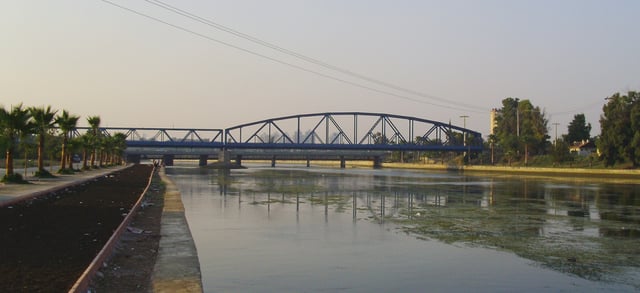
Demirköprü
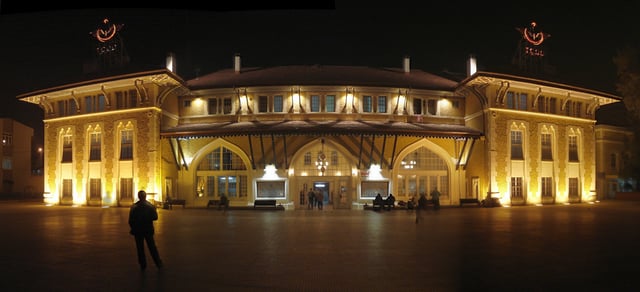
Adana Railway Station
Şakirpaşa Airport lies just west of the old town.
Together with the Central Bus Terminal and the Central Train Station, the three are the main locations for intercity transportation.
Şakirpaşa Airport, located within the city, is an international airport serving the Çukurova region. It is the sixth busiest airport in Turkey for passenger traffic, with 5.4 million passengers in 2015.[110] There are international flights to major cities of Germany, to Beirut, Jeddah, Erbil and Nicosia (TRNC), frequent domestic flights to Istanbul, Ankara, İzmir, Antalya, Trabzon, Bodrum and Van.[111]
Turkish State Railways (TCDD) runs five long distance lines that connect Adana to Ankara, Kayseri, Karaman, Konya and Elâzığ. All these lines are served at the Central Railway Station; some are also served at the other railway stations of the city—Şehitlik and Şakirpaşa stations at the west, Kiremithane, İncirlik and Yakapınar stations at the east. TCDD also runs three regional lines in Çukurova. Adana-Mersin Line runs as a commuter train with 27 train times daily.[112] Train service from Adana to Osmaniye–Islahiye[113] and to Iskenderun run once daily. Regional trains stop at all city stations.
Although they lost their popularity as private airlines introduced inexpensive flights to major cities, coaches are still the major form of transportation to and from Adana.
Adana has two intercity coach terminals providing service to almost all the cities and towns in Turkey.
Coach companies that serve transportation to cities west of Adana, depart from Central Coach Terminal, whereas the buses that serve cities east of Adana depart from Yüreğir Coach Terminal. A shuttle service is provided between the two terminals. Regional bus services from Adana to other places in Çukurova are plentiful and carried by bus and minibus co-operatives. Seasonal bus services to the high plains of Tekir, Bürücek and Kızıldağ run in summer, due to high demand of Adana residents escaping the heat of the city.
There is an extensive motorway network (O50-O59) in the region, connecting Adana to as far as Erdemli in the west, Niğde in the north, Şanlıurfa in the east and Iskenderun in the south. Traffic runs smoothly throughout the day; driving can take as little as 40 minutes to Mersin and two hours to Gaziantep.
Local transport
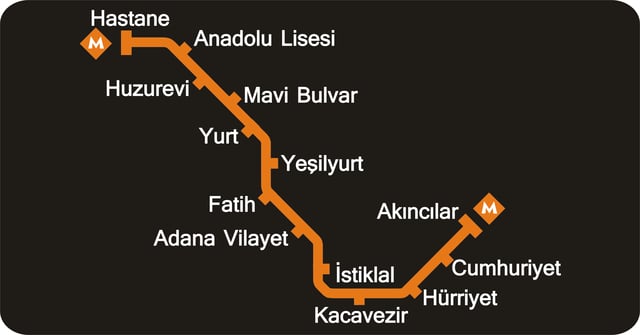
Map of the Adana Metro
Local transport in Adana is provided by Adana Transit Corporation (a division of the Metropolitan Municipality) and by dolmuş and bus co-operatives. Transit Corporation runs the metro and the municipal buses.
Adana Metro is a rail rapid transit system that extends 14 kilometres (9 miles) from the north-west to the city center and then to Yüreğir.[114] The metro serves 13 stations and can transport 21,600 passengers per hour one-way, a complete journey taking 21 minutes. The second line of the metro will run from Akıncılar to Çukurova University in the Sarıçam District. It will be 9.5 kilometres (6 miles) long and will have seven stations. The project is contracted in January 2010 and the construction is expected to start after the funding is received from the Ministry of Transportation.[115] Adana Metro will eventually extend to 23.5 kilometres (14.6 miles) and serve 20 stations.[116]
Adana Transit Corporation serves the city with 229 buses, eight of them designed specifically for disabled users.
Payment is collected by Kentkart Smartcard system.
Six Bus Co-operatives (known as Can buses) serve the city with 411 buses.
Kentkart and cash are accepted at these buses.
18 Dolmuş Co-operatives, with a total of 1,086 minibuses, provide service even to secondary streets. The only form of payment is by cash.
Cycling and walkability
The city of Adana is mostly flat and the warm weather makes it convenient for all year cycling and walking.
The square shape of the city, city center's location right at the center of the square and the river running straight north-south in the middle of the city create further advantage for cycling as a means of transportation.
Compact urban form due to dominance of high-rise buildings that are closely built, especially in Seyhan and Çukurova districts, make cycling from any end of the city to the city center to take less than 40 minutes.
Despite all the advantages, car-oriented urban planning since the 1950s caused cycling to take a minor part in commuting to work or school.
There are no bike lanes, but there are two bike paths, one along Fuzuli Street, the other along M. Kemalpaşa Boulevard—the latter not used by cyclists at all.
Bicycles for commuting are currently only used by residents of low-income neighborhoods.
Bicycle use for transportation is low all over Turkey,[117] but when compared to cities like İzmir, Konya and Eskişehir, Adana is less bicycle friendly.
Car-oriented urban planning became even more extreme since the 1980s, pedestrians seeing part of the sidewalks of the city's popular streets being converted into car-parking spots.
The rise in car ownership not only caused high traffic, but also led to drivers parking their cars on the sidewalks.
The city currently has no car-free squares or streets other than a few narrow ones.
There are plans to convert both ends of Taşköprü to squares and widen the sidewalks in the old town where it is difficult to walk at the peddler-invaded narrow sidewalks.
By far the most pedestrian friendly street of the city is Turgut Özal Boulevard; Kenan Evren and other major streets in Çukurova district are also very convenient for walking.
See also
List of people from Adana
List of twin towns and sister cities in Turkey
List of mayors of Adana
